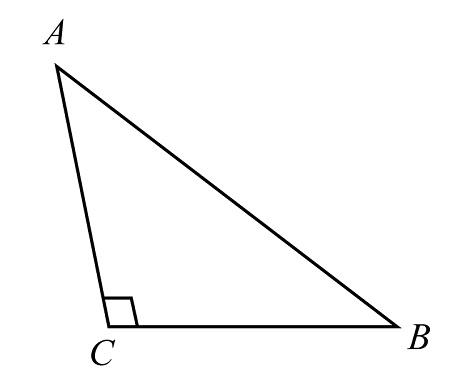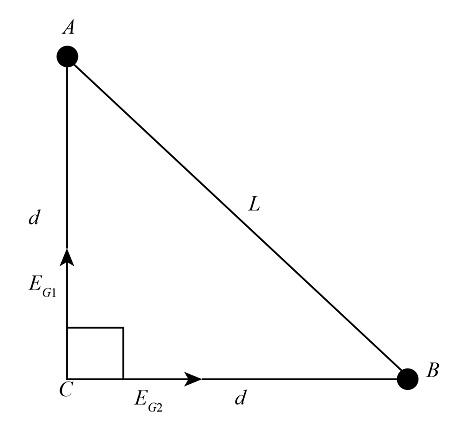
Two small particles of mass m each are placed at the vertices A and B of a right angle isosceles triangle. If $AB = l$, find the gravitational field strength at C.


Answer
568.2k+ views
Hint: First, draw the diagram of the triangle with all the information. After this, use the Pythagoras to determine the distance of point C form points A and B. Then, we will use the expression of the gravitational field strength to determine its magnitude at C.
Complete step by step answer:
Draw the diagram of the triangle.

We know that C is equidistant from the points A and B. so we will use the Pythagoras theorem for the calculation of the distance of point C from point A and B.
Therefore, we get
$ {d^2} + {d^2} = {L^2}\\$
$\implies 2{d^2} = {L^2}\\ $
$\implies d = \dfrac{L}{{\sqrt 2 }}$ …… (1)
Here, $d$ is the distance of the point C from A and B, and $L$ is the distance between A and B.
Write the expression of the gravitational field strength at point C due to the particle present at point A, so
${E_{G1}} = \dfrac{{Gm}}{{{d^2}}}$
Here, $m$ is the mass of the particle at A, $G$ is the gravitational constant and $d$ is the distance of point C form the A.
From equation (1), substitute the value of $d$ in the above equation, so the above equation becomes
$ {E_{G1}} = \dfrac{{Gm}}{{{{\left( {\dfrac{L}{{\sqrt 2 }}} \right)}^2}}}\\$
$\implies {E_{G1}} = \dfrac{{2Gm}}{{{L^2}}}$ …… (2)
Similarly, write the expression of the magnetic field strength at C due to particle present at B, so
${E_{G2}} = \dfrac{{Gm}}{{{d^2}}}$
Here, $m$ is the mass of the particle at B, $G$ is the gravitational constant and $d$ is the distance of point C form the B.
From equation (1), substitute the value of $d$ in the above equation, so the above equation becomes
$ {E_{G2}} = \dfrac{{Gm}}{{{{\left( {\dfrac{L}{{\sqrt 2 }}} \right)}^2}}}\\$
$\implies {E_{G2}} = \dfrac{{2Gm}}{{{L^2}}}$ …… (3)
From the diagram, we know that the angle between ${E_{G1}}$ and ${E_{G2}}$ is 90 degrees, so the resultant of the ${E_{G1}}$ and ${E_{G2}}$ becomes,
$E = \sqrt {{{\left( {{E_{G1}}} \right)}^2} + {{\left( {{E_{G1}}} \right)}^2}} $
Substitute the values form equation (2) and (3) in the above equation.
Therefore, we get
$ E = \sqrt {{{\left( {\dfrac{{2Gm}}{{{L^2}}}} \right)}^2} + {{\left( {\dfrac{{2Gm}}{{{L^2}}}} \right)}^2}} \\$
$\implies E = \sqrt {2{{\left( {\dfrac{{2Gm}}{{{L^2}}}} \right)}^2}} $
$\implies E = \sqrt 2 \left( {\dfrac{{2Gm}}{{{L^2}}}} \right)$
$ \implies \sqrt 2 \left( {\dfrac{{2Gm}}{{{L^2}}}} \right) $
Therefore, the gravitational field strength at C is $\sqrt 2 \left( {\dfrac{{2Gm}}{{{L^2}}}} \right)$.
Note:
Always draw the diagram of the given condition with the representation of distances between various points, direction of the gravitational field and other things for a better understanding of the solution. Also, remember the expression of the gravitational field strength.
Complete step by step answer:
Draw the diagram of the triangle.

We know that C is equidistant from the points A and B. so we will use the Pythagoras theorem for the calculation of the distance of point C from point A and B.
Therefore, we get
$ {d^2} + {d^2} = {L^2}\\$
$\implies 2{d^2} = {L^2}\\ $
$\implies d = \dfrac{L}{{\sqrt 2 }}$ …… (1)
Here, $d$ is the distance of the point C from A and B, and $L$ is the distance between A and B.
Write the expression of the gravitational field strength at point C due to the particle present at point A, so
${E_{G1}} = \dfrac{{Gm}}{{{d^2}}}$
Here, $m$ is the mass of the particle at A, $G$ is the gravitational constant and $d$ is the distance of point C form the A.
From equation (1), substitute the value of $d$ in the above equation, so the above equation becomes
$ {E_{G1}} = \dfrac{{Gm}}{{{{\left( {\dfrac{L}{{\sqrt 2 }}} \right)}^2}}}\\$
$\implies {E_{G1}} = \dfrac{{2Gm}}{{{L^2}}}$ …… (2)
Similarly, write the expression of the magnetic field strength at C due to particle present at B, so
${E_{G2}} = \dfrac{{Gm}}{{{d^2}}}$
Here, $m$ is the mass of the particle at B, $G$ is the gravitational constant and $d$ is the distance of point C form the B.
From equation (1), substitute the value of $d$ in the above equation, so the above equation becomes
$ {E_{G2}} = \dfrac{{Gm}}{{{{\left( {\dfrac{L}{{\sqrt 2 }}} \right)}^2}}}\\$
$\implies {E_{G2}} = \dfrac{{2Gm}}{{{L^2}}}$ …… (3)
From the diagram, we know that the angle between ${E_{G1}}$ and ${E_{G2}}$ is 90 degrees, so the resultant of the ${E_{G1}}$ and ${E_{G2}}$ becomes,
$E = \sqrt {{{\left( {{E_{G1}}} \right)}^2} + {{\left( {{E_{G1}}} \right)}^2}} $
Substitute the values form equation (2) and (3) in the above equation.
Therefore, we get
$ E = \sqrt {{{\left( {\dfrac{{2Gm}}{{{L^2}}}} \right)}^2} + {{\left( {\dfrac{{2Gm}}{{{L^2}}}} \right)}^2}} \\$
$\implies E = \sqrt {2{{\left( {\dfrac{{2Gm}}{{{L^2}}}} \right)}^2}} $
$\implies E = \sqrt 2 \left( {\dfrac{{2Gm}}{{{L^2}}}} \right)$
$ \implies \sqrt 2 \left( {\dfrac{{2Gm}}{{{L^2}}}} \right) $
Therefore, the gravitational field strength at C is $\sqrt 2 \left( {\dfrac{{2Gm}}{{{L^2}}}} \right)$.
Note:
Always draw the diagram of the given condition with the representation of distances between various points, direction of the gravitational field and other things for a better understanding of the solution. Also, remember the expression of the gravitational field strength.
Recently Updated Pages
Why are manures considered better than fertilizers class 11 biology CBSE

Find the coordinates of the midpoint of the line segment class 11 maths CBSE

Distinguish between static friction limiting friction class 11 physics CBSE

The Chairman of the constituent Assembly was A Jawaharlal class 11 social science CBSE

The first National Commission on Labour NCL submitted class 11 social science CBSE

Number of all subshell of n + l 7 is A 4 B 5 C 6 D class 11 chemistry CBSE

Trending doubts
What is meant by exothermic and endothermic reactions class 11 chemistry CBSE

1 Quintal is equal to a 110 kg b 10 kg c 100kg d 1000 class 11 physics CBSE

What are Quantum numbers Explain the quantum number class 11 chemistry CBSE

What is periodicity class 11 chemistry CBSE

What is a periderm How does periderm formation take class 11 biology CBSE

Mention the basic forces in nature class 11 physics CBSE




